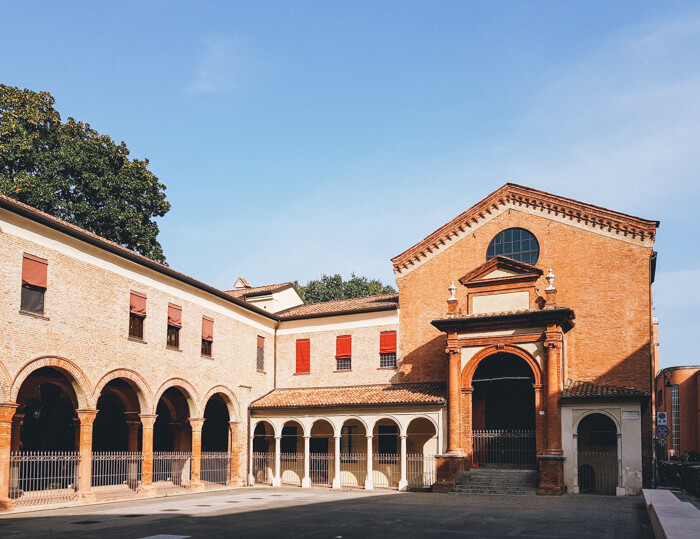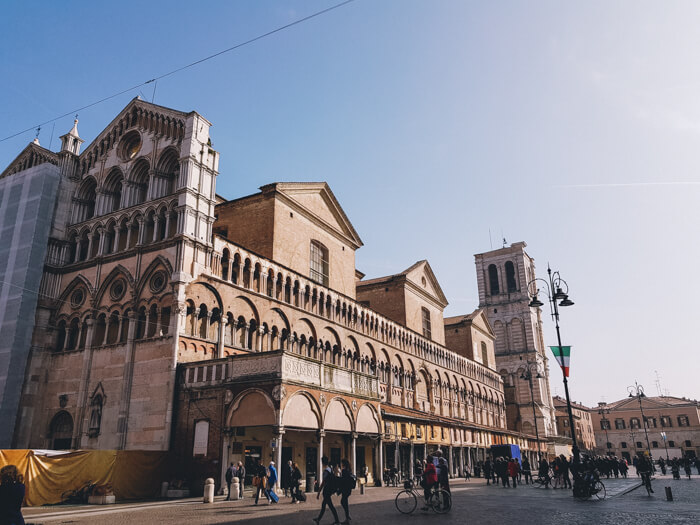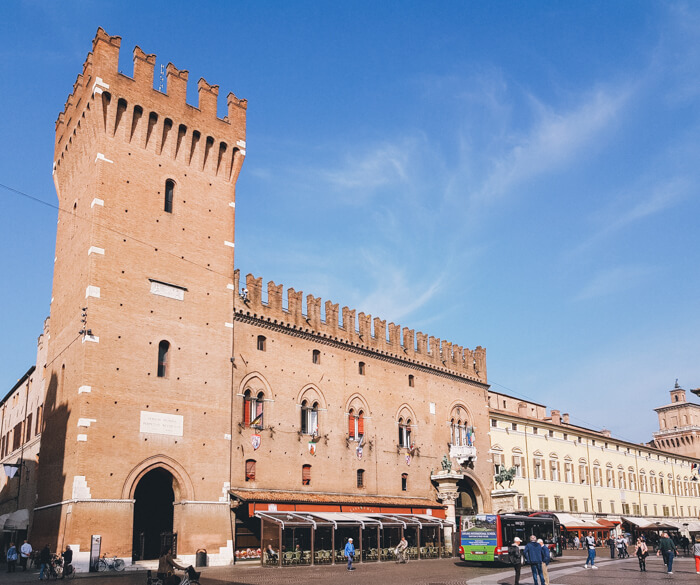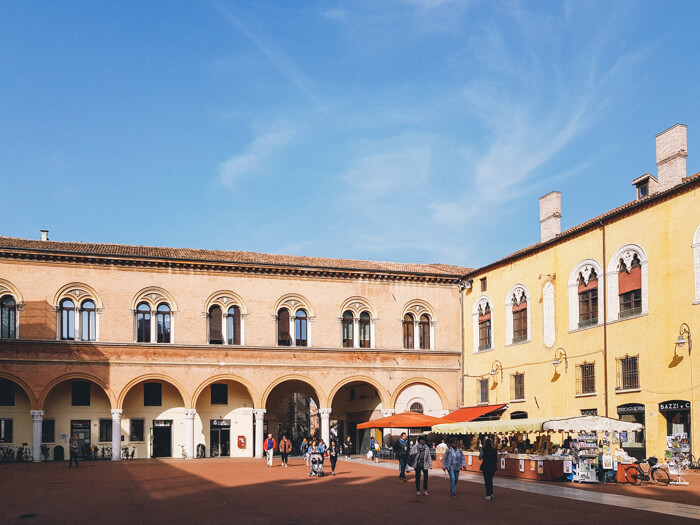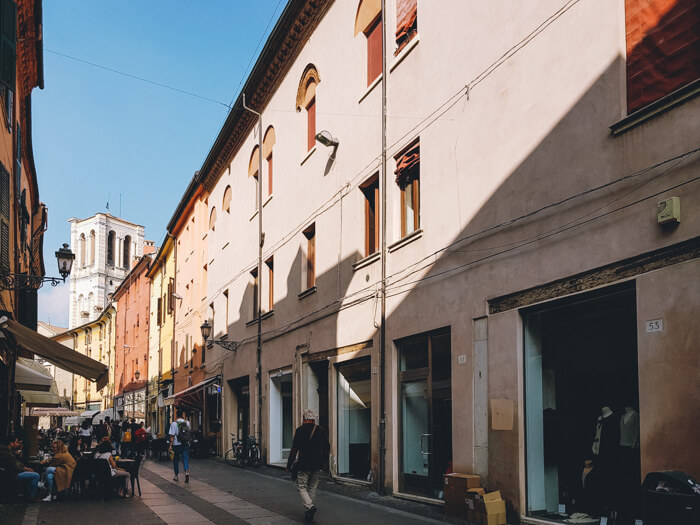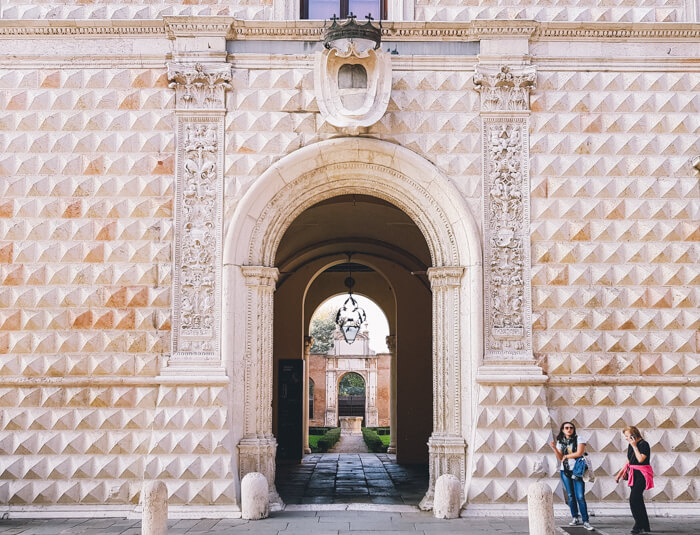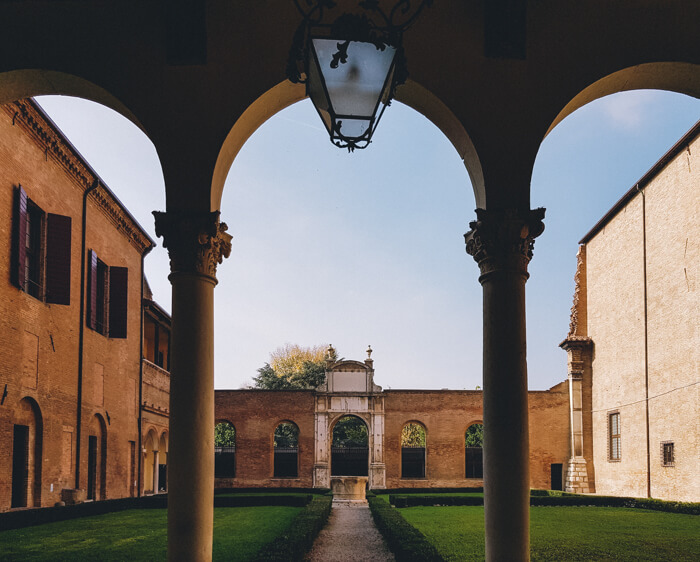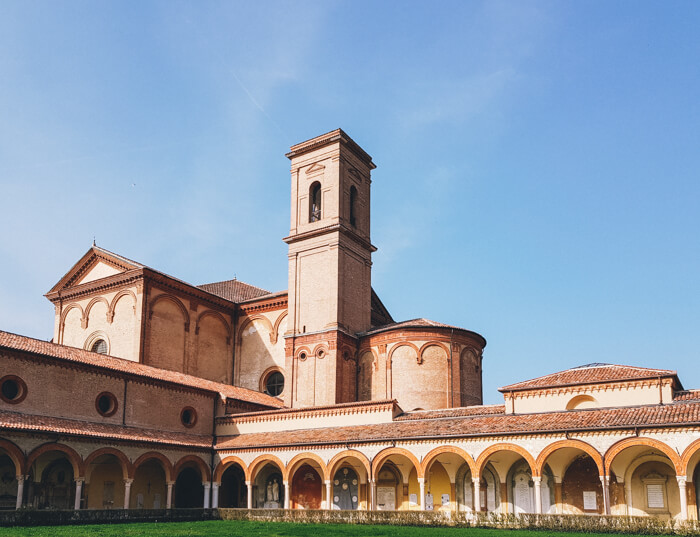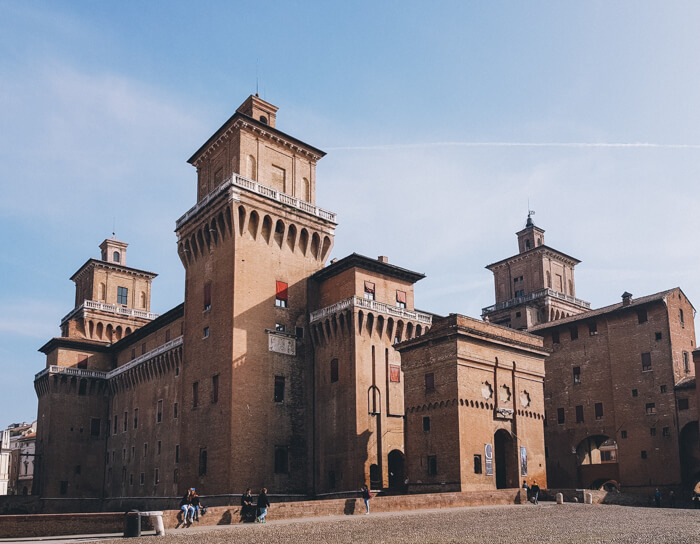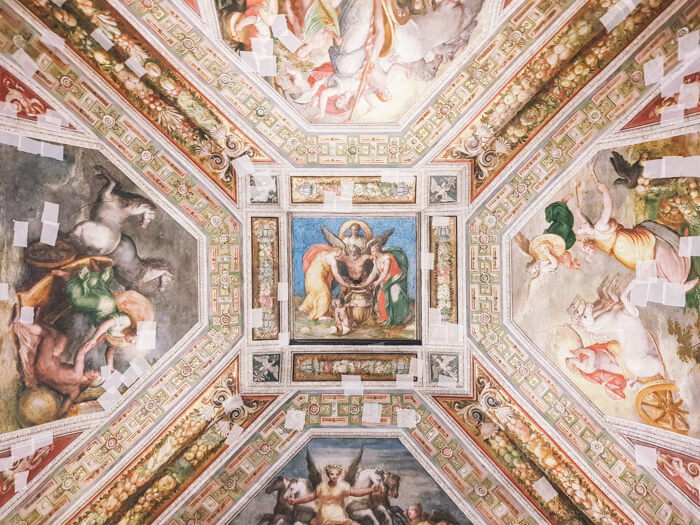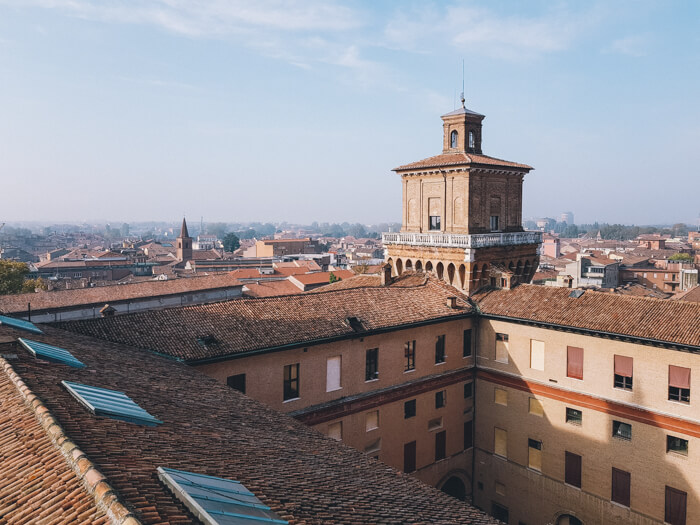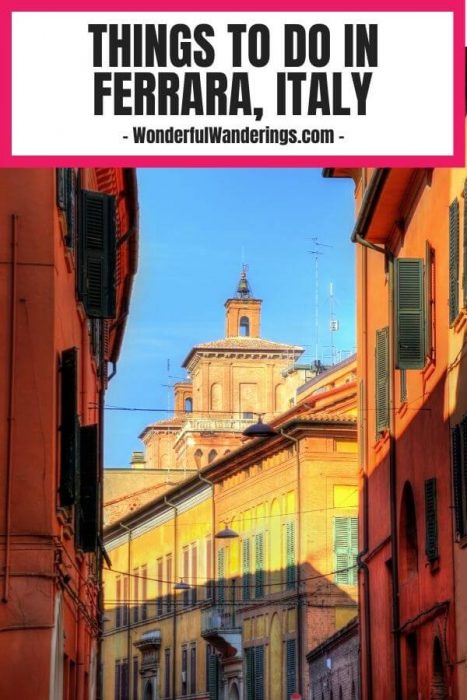Smaller than Bologna, less known than Parma and Modena, Ferrara might not be the first place on your list when you’re traveling to the Emilia Romagna region in Italy and yet I love it.
Why, you ask? Because there are plenty of things to do in Ferrara. Read on to find out what.
Contents
Things to do in Ferrara
Piazza Sant’Anna
At the quaint Piazza Sant’Anna you won’t find the usual hubbub as you do with many other plazas around Italy – and that’s what makes it so special.
The building that flanks the edges of the Piazza Sant’Anna was once a hospital devoted to the poor and sick. It was constructed on the site of an ancient monastery of Augustinian friars in 1445 and was the first hospital in the city. It is a peaceful place to explore, but, like many historical monuments, it has a patch of dark history.
Look around the plaza and you will see a plaque dedicated to the poet Torquato Tasso. He was locked up here from 1579 to 1586 in the wing of the hospital dedicated to madness.
However, it is believed that the poet was not mad at all, but was, in fact, a political opponent and was locked away after he went on an angry tirade against the Ducal Court.
A recent renovation of the plaza has given it the boost it needed to become a decent tourist attraction. The space was pedestrianized and the buildings were given a facelift. Now it can compete with some of the city’s better-known monuments.
Ferrara Cathedral
The Ferrara Cathedral is one of the most important Ferrara attractions. It’s dedicated to the patron Saint George and is therefore also known as the Cathedral of Saint George (Cattedrale di San Giorgio). Consecrated in 1135, it is without a doubt the most breath-taking piece of architecture in the city and if you visit Ferrara it should be at the top of your list of things to see.
The first thing you will notice upon approaching the Cathedral is its magnificent façade. This part of the Ferrara Cathedral fuses Renaissance and Romanesque styles and the result is absolutely stunning.
It sits facing the Piazza della Cattedrale and the Municipal Palace and is therefore right at the heart of Ferrara’s historic center, which is a UNESCO World Heritage site in its entirety.
Once you’ve finished gawping at the Cathedral’s exterior beauty, head inside and admire its elaborate interior. The original interior was destroyed by a fire in the 1700s and had to be rebuilt. It was reconstructed in a Baroque style and centers around a nave, with aisles either side. It also houses a number of impressive bronze statues.
Outside, old blends with new along the side of the Cathedral as some small stores have been built into the side of the edifice. This juxtaposition is actually much more charming than it sounds and shows how the town has encompassed its history with its daily modern life.
Museo della Cattedrale
The Cathedral Museum is attached to the Ferrara Museum but deserves its own mention. Not only does it explore the history of the Cathedral to which it is adjoined, but it also takes a look at Ferrara’s other religious buildings. It is one of the more academic things to do in Ferrara, but don’t let that put you off.
At the heart of the Museum is a beautiful courtyard, adorned with decorative arches. It is the epitome of tranquility.
Within the Museum, as you might expect, is a range of artifacts taken from the original Cathedral. Among these are the organ panels that depict the Annunciation and St George and the dragon. These were created by Cosimo Tura and will blow you away.
Although the Cathedral is free to enter, the Museum costs 6 EUR. But, if you enjoyed the Cathedral then the Museum is worth paying to explore as it will enhance what you have already seen and expand your understanding of the Cathedral.
While the Museum has quite a small collection inside, the building in which it is held is worth seeing in its own right.
Piazza del Municipio
The Piazza del Municipio is quite possibly the most majestic place in all of Ferrara. You can access it by passing under a magnificent arch directly opposite the Cathedral. The arch alone makes your visit to the Piazza del Municipio worthwhile. On either side of the arch are two imposing statues of Nicolò III and Borso D’Este, members of the Este family.
Once you are through the arch, you will open up onto a large courtyard. In one corner is the Scalone d’Onore (the Grand Staircase), which characterizes the entire plaza. The staircase was built in 1481 by Pietro Benvenuto and is covered with white marble. It’s worth a photo or two before you explore the rest of Piazza.
Of course, the main feature of the Piazza del Municipio is the Palazzo Ducale. This is the only architectural work by the historically important Pietro Benvenuto to have survived intact to the modern-day. The style of the palace recalls medieval castles to mind and has a tower situated on one side of it. The inside of the palace is extravagant and will teach you about how the Ferrara nobility lived.
Back in the Piazza, it is not unusual to see events taking place, especially in the summer when the weather is nice. Concerts, conferences, and other performances use the Piazza del Municipio as its stage. If there is nothing on when you are there, grab a gelato, sit on one of the steps and watch people walk by.
Old Jewish Ghetto
The history of the Jewish community in Italy has been turbulent to say the least and the Jewish Ghetto in Ferrara gives you just an inkling of what this might have been like. From 1627 until 1861, the Jewish population of Ferrara was forced into segregation from the rest of the town. To keep the Jews separate, they were placed in a ghetto.
Nowadays, you can explore the former Jewish Ghetto, which has been rejuvenated in a respectful way that embraces modernity without forgetting its terrible history.
The main thoroughfare is Via Mazzini, formerly known as Via Sabbioni. The gates of the ghetto have now been torn down and the houses have been renovated, but many original structures still remain.
At no.95 along the main road is the synagogue that was used by the Jews during their time of social isolation and is still in use today. You will also see the remnants of the welfare and education centers that were built by the Jewish community to maintain their intellect and religion when they were banned from general public services.
If you want to learn more about the Jewish community in Italy, and particularly in Ferrara, check out the new Museum of Italian Judaism and the Shoah, which is the Hebrew term for the Holocaust. The Museum examines the complex relationship between Christianity and Judaism in Ferrara and Italy on a larger scale.
Ironically, the Museum sits on the site of a former prison used to hold Jews during the Second World War. The prison did not close until 1992 and now it is being put to good use remembering those who were persecuted here in the past. The Museum presents the harrowing with the heart-warming in a fascinating exhibition that will give you context as you explore the former Jewish Ghetto.
Piazza Ariostea
If you’re looking for some green space while you wander through Ferrara, you will find it at the Piazza Ariostea. This delightful open space is perfect for sitting with friends in the sunshine and watching the world go by. You’re going to need to rest your weary legs at some point, so you might as well do it here.
Right at the heart of the Piazza is a column holding up a statue of the poet Ludovico Ariosto, the namesake of the Piazza. Surrounding it is grass, cut through by a circular path that has been asphalted and plays host to a number of events throughout the year.
The most famous event to take place in the Piazza Ariostea is the Palio di Ferrara. This is the oldest horse race in the world, starting in 1259 and recognized as a tradition 20 years later in 1279.
The event takes place on the last Sunday of May each year and sees the four districts within the walls of the city compete with one another.
During this event, the whole city comes alive as restaurants devise special suppers just for the occasion and locals deck themselves in traditional costume. It is a time for making merry, eating, and enjoying yourself – the horse race is just one part of this. If you can time your visit to arrive when this is on, you’ll be able to witness one of the most authentic and traditional experiences Ferrara has to offer.
Palazzo dei Diamanti
The outside of the Palazzo dei Diamanti is covered with over 8500 marble blocks made to look like large diamonds. That’s how it got its name (Palace of Diamonds). Despite this, the Palace is not particularly impressive from the outside and you would be forgiven for not giving it a second look while you stroll past. But, you shouldn’t just a building by its cover.
The main floor of this Palace houses the Pinacoteca Nazionale di Ferrara (The National Art Gallery of Ferrara). The art in this gallery dates all the way back to the Middle Ages, allowing you to watch the evolution of art in this region through the centuries. You’ll also find here several works from the Este family collection. The Este family was the family that ruled over Ferrara for over 350 years.
On the floor below the gallery is the Civic Gallery of Modern and Contemporary Art – an exhibition space that regularly plays host to temporary exhibitions. Check the schedule while you are there to see what is on show. In the past, there have been exhibitions on Monet, Munch, Degas, Matisse, Tura and dozens of other famous artists.
Chiesa di San Cristoforo alla Certosa
This terracotta church is situated away from the city center but is easily accessible by foot or by bus. Construction of the church began in 1498 and was completed 1551 under the supervision of Bagio Rosetti. At this point in your tour of Ferrara you might be getting tired of historical and religious monuments, but this church really shouldn’t be missed.
Inside the church, you will find a wealth of art, including sculptures, paintings, and furnishings and it is free to go inside, making it a great activity if you are on a budget. Aside from the art, the internal architecture of the church is impressive, comprising a single nave and six grandiose side chapels.
Italian history has been sculpted by religion, more so than many other countries in the world. It has undergone enormous changes over the centuries and is widely considered the cradle of culture and civilization, not just of Europe, but of the world as a whole. The Chiesa di San Cristoforo alla Certosa is just one of many places where you can get a taste of how and why Italy became the way it is today.
Castello Estense
Finally, we come to Ferrara’s pièce de résistance, the Castello Estense (Estense Castle). This fortified castle was designed to keep the ruling family, the Este Family, safe from disgruntled peasants who may be inclined to revolt. The trigger for its construction was a revolt, which led to a member of the rulers being torn limb from limb by the people of Ferrara.
Construction of the Castle began in 1385 and the Estes made it their permanent home in the late 15th century. The Castle is truly majestic to behold with its fortified walls and moat. Just looking at it is enough to transport you back to medieval times. While the Castle looks pretty, its history is just as sordid as you might expect from a family that abided by no rules but their own.
It is said that Nicolò III was the main character in turning the Castle from a house into a home. The Marquis was known for his collection of mistresses who lived in the Castle and took turns satisfying his needs. At one point there may have been up to 1000 concubines living in the Castle.
Despite the Marquis’ rampant infidelity, he would not tolerate it in anyone else. One day he caught his wife and his illegitimate son (her stepson) together and had them both beheaded.
Both the history and the architecture of the Castello Estense are fascinating and you can learn more about them as you peruse the inner rooms of the Castle. Entrance to the Castle is 8 EUR and is worth every penny to see how the family that ruled over Ferrara for so long-lived.
And that’s it! I hope you have a good idea of what to see in Ferrara now. Let me know if you go :-)
How to get to Ferrara
Ferrara can easily be done as a day trip from Bologna or from other nearby cities by train. If you have a car while you’re in Italy, you can also always just drive there.
&bsp;
PIN FOR LATER

